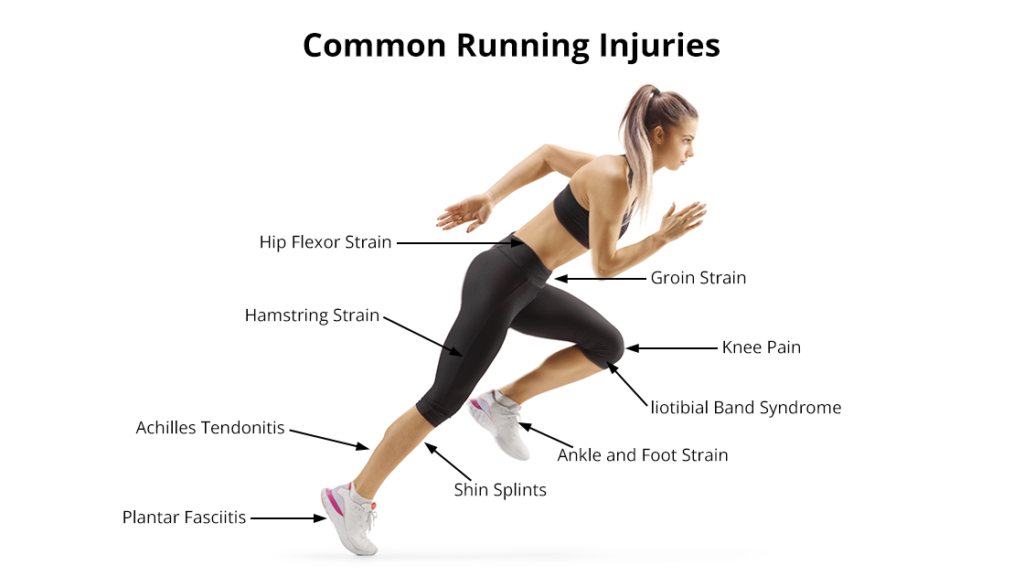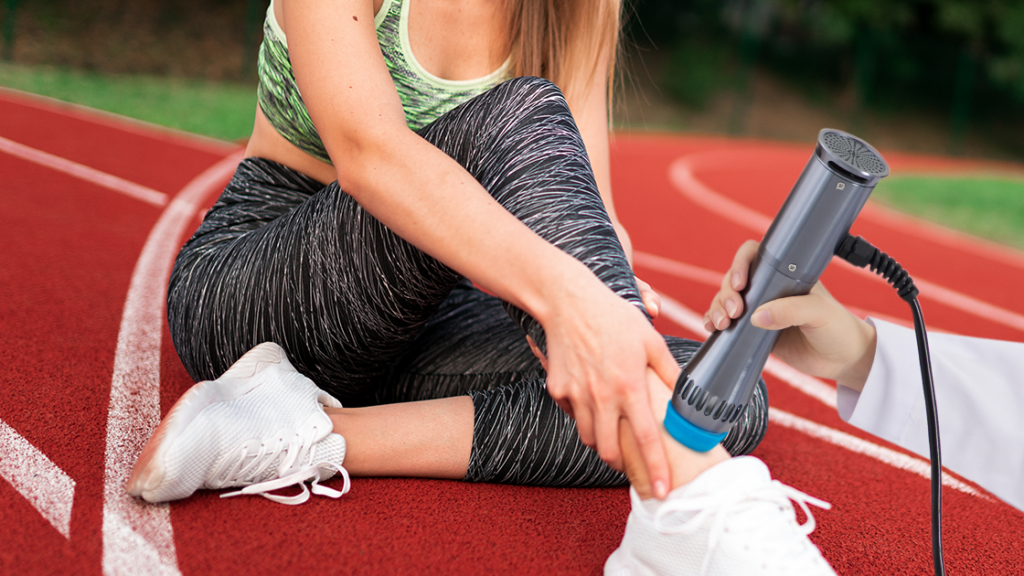Introduction
Running is one of the most popular and accessible forms of cardiovascular exercise. It provides significant benefits for cardiovascular health, mental well-being, and weight management. However, it also comes with a high incidence of overuse injuries due to the repetitive impact forces involved. Studies show that up to 79% of runners experience at least one injury annually, ranging from mild strains to chronic tendon pathologies. While most running injuries are initially managed with conservative strategies—like rest, ice, compression, elevation (RICE), physical therapy, and footwear modifications—these measures often fail to resolve long-standing tissue degeneration or pain syndromes. In such cases, extracorporeal shockwave therapy (ESWT) has emerged as a non-invasive, evidence-based solution to accelerate recovery, relieve pain, and restore function in injured runners.
Understanding Running Injuries
The Impact of Repetitive Stress
Running involves cyclical loading patterns that place repeated submaximal stress on musculoskeletal structures, especially the lower limbs. Every foot strike generates ground reaction forces up to 2.5 times body weight, which must be absorbed and transferred efficiently through the feet, ankles, knees, and hips. When tissue load exceeds the ability to recover, microscopic damage accumulates, leading to inflammation, tendon degeneration, and eventually pain and dysfunction. This process is compounded by factors like improper biomechanics, inadequate recovery, insufficient strength, or poor footwear choices. As runners often push through early signs of discomfort, microtrauma can evolve into chronic pathology.
Top Injuries Runners Face

Plantar Fasciitis
This is one of the most common foot injuries among runners. It presents with sharp heel pain, particularly during the first steps in the morning or after prolonged rest. The plantar fascia—a thick fibrous band supporting the foot arch—undergoes microtears and inflammation from repetitive traction and impact forces. Chronic cases may involve degeneration and calcification at the heel attachment, limiting mobility and training capacity.
Achilles Tendinopathy
Achilles tendinopathy involves degenerative changes in the Achilles tendon due to overuse. Runners may experience morning stiffness, swelling, and pain during push-off. Tendon overload, sudden changes in mileage or training surfaces, poor calf flexibility, and biomechanical faults like overpronation are common contributing factors. Chronic tendinopathy leads to disorganized collagen fibers and impaired tendon elasticity.
Medial Tibial Stress Syndrome (Shin Splints)
This overuse injury is characterized by diffuse pain along the medial border of the tibia. It’s caused by excessive traction of the soleus and tibialis posterior muscles on the periosteum of the tibia, leading to localized inflammation. Risk factors include training errors, flat feet, and inadequate shock absorption from footwear.
Iliotibial Band Syndrome (ITBS)
ITBS results in sharp lateral knee pain, particularly when the knee flexes around 30 degrees. The iliotibial band, a thick fascial structure running along the thigh, rubs over the lateral femoral epicondyle during repetitive motion. This friction causes irritation and inflammation, especially in runners who frequently run downhill or have weak hip abductors.
Patellar Tendinopathy (Runner’s Knee)
This condition refers to pain at the patellar tendon, just below the kneecap. It’s often linked to repetitive jumping or running activities, leading to collagen disruption in the tendon. Patellar tendinopathy reduces the ability to generate explosive movements and may interfere with stairs, squats, and sustained running.
Why Conservative Treatments Often Fail
Conservative care is important but not always curative, especially for chronic tendinopathies or fascial injuries. In many cases, rest and anti-inflammatory strategies provide only short-term relief, while underlying degenerative changes persist. Tendon and fascia tissues have limited blood supply, which slows healing. Moreover, over-reliance on passive therapies without biomechanical correction or progressive loading fails to rebuild tissue integrity. Chronic cases often involve fibrotic tissue, neovascularization, or calcific deposits that resist manual therapy. Patients who delay seeking advanced care or skip rehabilitation protocols often experience symptom recurrence or prolonged recovery.
Overview of Shockwave Therapy for Running Injuries
Definition of Shockwave Therapy
Shockwave therapy, also known as extracorporeal shockwave therapy (ESWT), is a non-invasive treatment method that uses acoustic waves to stimulate healing in musculoskeletal tissues, particularly in tendons, ligaments, and muscles. The technology initially evolved from lithotripsy, a medical procedure designed to break up kidney stones. Over time, medical professionals have adapted it for soft tissue injuries, chronic pain management, and improving recovery times. Shockwave therapy is used extensively in sports medicine for runners dealing with overuse injuries, such as tendinopathies or fasciitis. It works by delivering short bursts of high-energy sound waves to the affected area. These sound waves create mechanical pressure on the tissues, generating a biological response that aids in healing. Shockwaves can be focused or radial, with focused waves penetrating deeper tissue layers, making them ideal for deep-seated injuries like tendon damage. Radial shockwaves, on the other hand, are more spread out, and are typically used for treating surface-level or superficial injuries.
How Shockwave Stimulates Healing in Musculoskeletal Tissue
When shockwaves are applied to the injured tissue, they produce mechanical stress on the cellular structure, leading to various beneficial effects. This includes:
- Increased circulation and blood flow: Shockwave therapy promotes vasodilation and stimulates the formation of new blood vessels (neovascularization). This enhances the delivery of oxygen and nutrients to the injured area, speeding up the healing process.
- Collagen production: Shockwaves activate fibroblasts (collagen-producing cells), encouraging the synthesis of new collagen fibers. Collagen is essential for repairing damaged tendons and ligaments.
- Breakdown of scar tissue: Over time, chronic injuries may lead to the formation of scar tissue or calcification, which can inhibit normal tissue function. Shockwave therapy helps break down these stiff, fibrous tissues, allowing healthier, more elastic tissue to form.
- Pain reduction: Shockwaves stimulate the release of endorphins, the body’s natural painkillers. They also desensitize nerve endings, which leads to a reduction in pain transmission from the injury site.
- Cellular stimulation: Shockwaves cause microtrauma at the cellular level, which activates cellular repair processes. This stimulation helps the tissue regenerate and heal more effectively.
What to Expect in a Treatment Session
A typical shockwave therapy session lasts between 10 to 20 minutes, depending on the size of the treatment area. The number of sessions required varies, but typically 3-6 sessions are recommended, spaced a week apart. Results can often be felt after 2-3 sessions, with significant improvement noticed by the third week of treatment. Here’s a detailed breakdown of what to expect during a session:
- Preparation: The therapist will first locate the injured area using palpation. Then, a conductive gel is applied to improve the transmission of the shockwaves to the tissue.
- Shockwave application: The handheld shockwave device is positioned over the injury site. The therapist will adjust the energy intensity depending on the injury’s severity and the patient’s pain tolerance. Patients will feel a mild, tapping sensation as the shockwaves are delivered.
- Post-treatment: After the treatment, patients may experience slight discomfort or tenderness in the treated area, which typically subsides within a few hours. While there is no downtime after the session, it is recommended to avoid any strenuous activities for 48 hours to allow the tissue to respond to the treatment.

Benefits of Shockwave Therapy for Runners
Promotes Fast Tissue Regeneration
One of the primary benefits of shockwave therapy is its ability to accelerate tissue regeneration. When runners experience injuries like tendinitis, the healing process often stalls, leading to prolonged pain and limited mobility. Shockwaves help by stimulating the production of collagen, which is essential for rebuilding tendon and ligament structures. This fast-tracks the healing process and ensures that the tissue heals in a way that mimics its natural structure, improving overall strength and flexibility. Moreover, shockwave therapy helps in stimulating fibroblasts—the cells that play a major role in wound healing by generating collagen. This can be especially important for chronic injuries that fail to heal through conservative treatments alone.
Reduces Pain Without Medication
Pain management is a common challenge for runners with chronic injuries. While oral medications, NSAIDs, and corticosteroid injections can offer temporary relief, they often come with long-term side effects and do not address the root cause of the pain. Shockwave therapy, on the other hand, provides pain relief without drugs. The acoustic waves stimulate the release of endorphins—natural painkillers produced by the body—and reduce the sensitivity of nerve endings, leading to a noticeable decrease in pain. This allows athletes to return to training or competition with less reliance on medications, which can impair performance or result in unwanted side effects.
Breaks Down Scar Tissue and Calcification
Scar tissue and calcification are common in chronic tendon injuries, such as Achilles tendinopathy or plantar fasciitis. These rigid formations impede normal tissue movement and flexibility. Shockwave therapy helps to break down these abnormal tissue formations, which restores function and mobility to the affected area. By disrupting the calcified deposits and scar tissue, shockwave therapy makes way for healthier tissue regeneration. In conditions like calcific tendinopathy, where calcium deposits accumulate in the tendons, shockwave therapy is particularly effective. The shockwaves physically break up the calcium buildup, which not only alleviates pain but also enhances tendon mobility and overall function.
Speeds Up Return to Running
Injuries, particularly chronic conditions, often sideline runners for extended periods. Recovery times can stretch over weeks or even months, depending on the severity of the injury. Shockwave therapy offers a faster recovery time, allowing runners to return to their training or competition schedule more quickly. Since shockwaves stimulate faster tissue regeneration and healing, they help injured runners return to their normal activity level much sooner than traditional therapies or rest alone.
Accelerated Recovery Timelines
For overuse injuries or repetitive strain injuries that develop gradually over time, shockwave therapy can accelerate the recovery timeline significantly. Conditions such as Achilles tendinopathy, plantar fasciitis, and shin splints may require several months of rehabilitation, but with shockwave therapy, this timeline is often reduced by up to 30-50%. The combination of reducing inflammation, stimulating collagen production, and enhancing blood circulation helps the injured tissue repair and regenerate much more rapidly.
Performance Optimization and Injury Resilience
Post-recovery, shockwave therapy does not only heal injuries—it also optimizes performance. By improving the overall health of tissues, shockwave therapy increases the strength and elasticity of tendons and muscles, making them more resilient to future injuries. For runners, this means better performance metrics such as increased stride length, reduced muscle stiffness, and improved joint flexibility. Shockwave therapy not only addresses the injury at hand but also helps to build a stronger, more injury-resilient musculoskeletal system, enabling athletes to perform at their best and recover faster.
Maximizing Shockwave Therapy Outcomes
Optimal Timing Within Injury Stages
For shockwave therapy to be most effective, it should be applied at the right stage of the injury. In the acute phase (typically within the first 48 hours), the injury is still inflamed and swollen, and shockwave therapy may exacerbate the symptoms. In the subacute or chronic stages, when the inflammation has reduced but healing has stalled, shockwave therapy becomes most beneficial. For runners, the ideal time to introduce shockwave therapy is when pain has persisted for several weeks, and other conservative treatments have failed. This could include tendon injuries like Achilles tendinopathy or IT band syndrome, which are resistant to rest and standard rehabilitation protocols.
Combining Shockwave with Biomechanical Adjustments
While shockwave therapy addresses the injury at the tissue level, it does not correct underlying biomechanical issues that may have contributed to the injury in the first place. To get the best results, shockwave therapy should be combined with biomechanical assessments and adjustments. This could involve:
- Gait analysis to identify movement patterns that put excess strain on certain muscles or joints.
- Orthotics or proper footwear to correct imbalances.
- Stretching and strengthening exercises to improve flexibility and muscular strength.
Preventive Use in High-Volume Runners
For runners who train intensely or at high volumes, preventive shockwave therapy can help maintain tissue health and avoid injuries. Many elite runners use shockwave therapy proactively, especially if they feel early signs of discomfort or tightness in high-stress areas like the Achilles tendon, IT band, or calves. By using shockwave therapy early, these athletes can prevent minor injuries from becoming more severe, thereby avoiding downtime and continuing their rigorous training schedules.
Nutritional and Lifestyle Factors That Support Healing
Proper nutrition and lifestyle habits are integral to the success of shockwave therapy. By aligning these lifestyle factors with shockwave therapy, runners can ensure they recover optimally and perform at their peak:
- Protein-rich diets: Collagen production and tissue regeneration rely on amino acids, so adequate protein intake is vital for recovery.
- Vitamin C and antioxidants: These nutrients promote tissue repair and reduce oxidative stress, aiding faster healing.
- Proper rest and sleep: Sleep is when much of the body’s healing occurs, so getting sufficient rest is critical for recovery.
- Load management: Overloading the body with too much exercise too soon after shockwave therapy can lead to reinjury, so careful return-to-training protocols must be followed.
What Runners and Clinicians Often Overlook
Despite the growing use of shockwave therapy (ESWT) in treating running injuries, both athletes and clinicians sometimes overlook critical aspects of its application, which can impact the effectiveness of treatment. Let’s take a closer look at some of the key considerations.
Beyond Injury: Enhancing Muscle Activation
Shockwave therapy is not just for treating injuries—it can also enhance muscle activation. For runners, using shockwave therapy even when not injured can improve muscle elasticity, strength, and coordination. It helps muscles respond faster to physical demands, optimize running form, and speed up recovery post-training. Runners may see improved performance and reduced injury risk with consistent use.
Non-Responders: Reasons and Solutions
Not all runners respond to shockwave therapy in the same way. If treatment doesn’t work as expected, it could be due to misdiagnosis, incorrect intensity, or the chronicity of the injury. Non-responders may need adjustments in therapy parameters, a re-evaluation of the injury, or a combination of other therapies like physical therapy to enhance recovery. Customizing the approach can help achieve better results.
Equipment Quality and Type Matter
The type of shockwave device used significantly impacts treatment success. Radial shockwave is effective for surface-level injuries, while focused shockwave is better for deeper tissue injuries. Higher-quality machines with appropriate settings provide better precision and more effective treatment, which is crucial for consistent results.
Future Directions in Shockwave Therapy
As shockwave therapy advances, we may see its expanded use in combination with other therapies like laser treatments and stem cell therapy. There is growing interest in its role in injury prevention, particularly for high-volume runners, and its potential in animal medicine, especially for horses and dogs.
Common Misconceptions About Shockwave Therapy
Despite its success, several myths surround shockwave therapy. Some believe it is only for chronic injuries or that it is painful. In reality, shockwave therapy is beneficial for both acute and chronic injuries and is generally well-tolerated. It is also not a one-size-fits-all treatment; effectiveness depends on the injury type, shockwave parameters, and other factors.
Conclusion
Shockwave therapy has rapidly become a cornerstone in treating running injuries, offering a non-invasive, drug-free option for healing and recovery. Whether it’s used to treat chronic injuries like Achilles tendinopathy or acute injuries such as muscle strains, shockwave therapy has shown impressive results in stimulating tissue regeneration, reducing pain, and improving overall athletic performance. For runners, the benefits of shockwave therapy are undeniable. However, to maximize these benefits, both athletes and clinicians must be aware of several critical factors, such as the timing of treatment, the quality of equipment, and the importance of combining shockwave therapy with other therapeutic modalities. By adopting a holistic approach and incorporating shockwave therapy into a well-rounded recovery and performance strategy, runners can significantly improve their chances of staying injury-free and achieving their performance goals.
References
Extracorporeal shockwave therapy in musculoskeletal disorders:
https://pmc.ncbi.nlm.nih.gov/articles/PMC3342893
Shock Wave Therapy for Acute and Chronic Soft Tissue Wounds: A Feasibility Study:
https://www.sciencedirect.com/science/article/abs/pii/S0022480407000078
Effectiveness of shockwave therapy in the treatment of plantar fasciitis:
